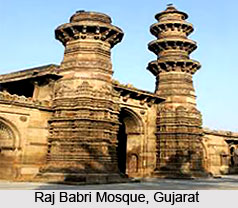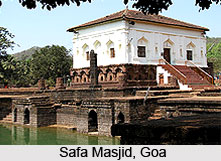 Islam had spread throughout the country since ages ago and a number of mosques had been established in different parts of India over years. Mosques of Western India are the beautiful testaments of the fact that Muslim cultures and traditions are highly prevalent in the western region of the country. These mosques have been well maintained and some of the very ancient ones stand as prominent monuments till date.
Islam had spread throughout the country since ages ago and a number of mosques had been established in different parts of India over years. Mosques of Western India are the beautiful testaments of the fact that Muslim cultures and traditions are highly prevalent in the western region of the country. These mosques have been well maintained and some of the very ancient ones stand as prominent monuments till date.
Mosques of Gujarat
Several mosques are situated in Gujarat. Sultan Ahmed Shah mosque is one of the most ancient mosques of the city built in 1414 AD by Sultan Ahmed Shah, from which the mosque takes its name. It is located towards the left of the Bhadra Fort. Another mosque of this state is Siddi Bashir Mosque. The mosque is famous for its unique architecture where the minarets of the mosque, on shaking, vibrate and become stable immediately after that. Raj Babri Mosque is another ancient mosque established in 15th century during the reign of King Ahmed Shah. It is well known for its shaking minarets. Rani Rupmati Mosque, constructed by Sultan Mehmud Beghara, is located in Ahmedabad. The king named this mosque in the honour of his Hindu wife Rupmati. In Ahmedabad, another mosque is situated known as Rani Sipri Mosque, constructed in 1514 AD by Rani Sipri. The mosque exhibits an amalgamation of Islamic and Hindu architecture. Mahabat Maqbara was built in 1892 and is famous as the best testament of Indo-Islamic style of architecture. Another popular mosque of Gujarat is Jami Masjid which is known for its architecture where 140 pillars support the ceiling. It is an ancient mosque of 19th century. Sidi Saiyyed Mosque is also located in Ahmedabad. It was established in 1573 and is considered as the most beautiful mausoleum of the state. Its main attraction is the carved stone latticework windows. Other mausoleums of Gujarat include Bawaman Mosque, Mai Puri Masjid, Ratan Bai Masjid, Sarkhej Roza etc.
 Mosques of Goa
Mosques of Goa
Although Goa is believed to be a Christians state, it also houses a number of mosques. Safa Masjid, located in Ponda Taluka, is one of the oldest and biggest mosques of Goa. It was constructed by Ibrahim Adilshan of Bijapur in 1560. Jama Masjid is situated in Sanguem near Margao. Another Jama Masjid is located in Panaji and is the oldest mosque of this region. Built in 18th century, the interior of the mosque is adorned with black and white marbles having Islamic designs. Namazgah mosque was established by Prince Akbar as a celebration of their conquest over Catholic Goa. Surla Tar Mosque is an ancient mosque located in Surla village. It was constructed by Ismail Adilshah in 1560 AD. Another famous mausoleum of Goa is Safa Masjid situated in Shahpur district. This elegant structure was built by Ibrahim Adil Shah who was the Sultan of Bijapur in the year 1560. It is embellished with Islamic arches on the walls of the mosque.
Mosques of Maharashtra
Maharashtra also enlists a number of mosques. Jama Masjid, located in Mominpura of Nagpur, is the biggest mausoleum of this region. Shah Ganj Masjid is considered as one of the most beautiful mosque of the country having amazing architecture. Another mosque of the state is Dwarkamai Masjid. It is famous for being the place where Sai Baba had stayed for about 60 years. A sacred fire, also known as Dhuni, always keeps on burning in the mosque which was once lit by Sai Baba. Masjid of Biloli is an ancient stone mausoleum built more than 300 years ago. Gharib Nawaz Mosque is also located in Nagpur. The mosque has an exquisite marble interior having Islamic arches with calligraphic verses of Quran.
These mosques represent excellent architecture and amazing artistry. Some of the mosques have a blend of Hindu and Islamic styles of architecture. Apart from being the popular centres for spiritually, these mosques also attract a sea of tourists from all over the world.





















